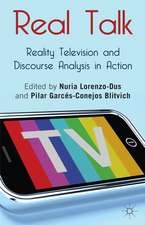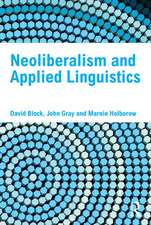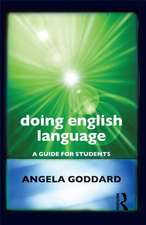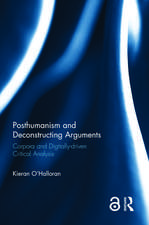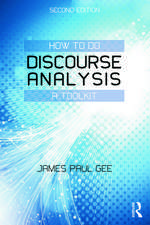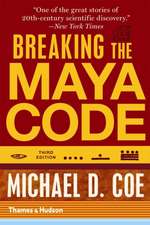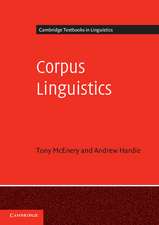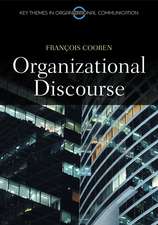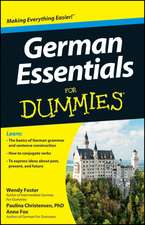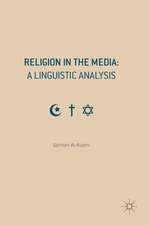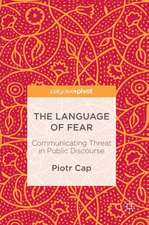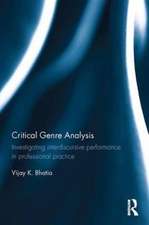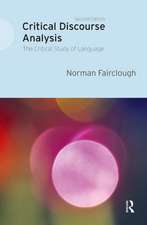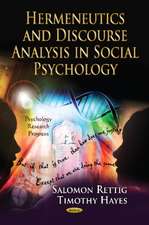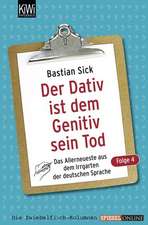Multimodality and Active Listenership: A Corpus Approach: Corpus and Discourse
Autor Dawn Knighten Limba Engleză Paperback – 27 mar 2013
| Toate formatele și edițiile | Preț | Express |
|---|---|---|
| Paperback (1) | 257.68 lei 6-8 săpt. | |
| Bloomsbury Publishing – 27 mar 2013 | 257.68 lei 6-8 săpt. | |
| Hardback (1) | 1008.01 lei 6-8 săpt. | |
| Bloomsbury Publishing – 12 oct 2011 | 1008.01 lei 6-8 săpt. |
Din seria Corpus and Discourse
-
 Preț: 179.36 lei
Preț: 179.36 lei -
 Preț: 169.35 lei
Preț: 169.35 lei -
 Preț: 168.92 lei
Preț: 168.92 lei - 23%
 Preț: 197.86 lei
Preț: 197.86 lei - 13%
 Preț: 229.59 lei
Preț: 229.59 lei - 13%
 Preț: 257.50 lei
Preț: 257.50 lei - 22%
 Preț: 1064.84 lei
Preț: 1064.84 lei - 23%
 Preț: 199.03 lei
Preț: 199.03 lei - 18%
 Preț: 304.94 lei
Preț: 304.94 lei - 14%
 Preț: 1008.59 lei
Preț: 1008.59 lei - 13%
 Preț: 257.59 lei
Preț: 257.59 lei - 22%
 Preț: 258.24 lei
Preț: 258.24 lei - 22%
 Preț: 224.29 lei
Preț: 224.29 lei - 22%
 Preț: 258.15 lei
Preț: 258.15 lei - 21%
 Preț: 218.91 lei
Preț: 218.91 lei - 30%
 Preț: 570.76 lei
Preț: 570.76 lei - 19%
 Preț: 495.61 lei
Preț: 495.61 lei - 11%
 Preț: 375.61 lei
Preț: 375.61 lei - 8%
 Preț: 299.86 lei
Preț: 299.86 lei - 19%
 Preț: 344.75 lei
Preț: 344.75 lei - 13%
 Preț: 257.97 lei
Preț: 257.97 lei - 22%
 Preț: 258.42 lei
Preț: 258.42 lei - 22%
 Preț: 258.77 lei
Preț: 258.77 lei - 28%
 Preț: 374.34 lei
Preț: 374.34 lei - 14%
 Preț: 570.02 lei
Preț: 570.02 lei - 30%
 Preț: 569.13 lei
Preț: 569.13 lei - 22%
 Preț: 1125.24 lei
Preț: 1125.24 lei - 14%
 Preț: 298.74 lei
Preț: 298.74 lei - 22%
 Preț: 1008.01 lei
Preț: 1008.01 lei
Preț: 257.68 lei
Preț vechi: 331.29 lei
-22% Nou
Puncte Express: 387
Preț estimativ în valută:
49.31€ • 51.29$ • 40.71£
49.31€ • 51.29$ • 40.71£
Carte tipărită la comandă
Livrare economică 15-29 aprilie
Preluare comenzi: 021 569.72.76
Specificații
ISBN-13: 9780567175151
ISBN-10: 0567175154
Pagini: 272
Ilustrații: black & white illustrations
Dimensiuni: 156 x 234 x 14 mm
Greutate: 0.37 kg
Editura: Bloomsbury Publishing
Colecția Bloomsbury Academic
Seria Corpus and Discourse
Locul publicării:London, United Kingdom
ISBN-10: 0567175154
Pagini: 272
Ilustrații: black & white illustrations
Dimensiuni: 156 x 234 x 14 mm
Greutate: 0.37 kg
Editura: Bloomsbury Publishing
Colecția Bloomsbury Academic
Seria Corpus and Discourse
Locul publicării:London, United Kingdom
Caracteristici
Investigates the patterned use of specific forms and functions of backchanneling phenomena in conversation.
Notă biografică
Dawn Knight is a Research Fellow at the Centre for Research in Applied Linguistics (CRAL), University of Nottingham, UK.
Cuprins
Acknowledgements Acronyms List of tables List of figures 1. Introduction2. Corpora Beyond Text - Developing Multimodal Corpora 3. Language and Gesture 4. Backchannels 5. Analysing Backchanneling Head Nods 6. A Coding Matrix for Backchanneling Phenomena 7. Semi-automated Head Nod Tracking 8. Concluding Remarks Glossary ReferencesIndex
Recenzii
In face-to-face interaction movements of the head and body can carry meaning that is as important as the words. Yet in the analysis of talk, this is seldom acknowledged or methodically handled. Dawn Knight's clear and persuasive account of how such movements can be systematically recorded and analyzed achieves a major step forward for both discourse analysis and corpus linguistics.
This is an important book documenting the move from mono-modal to multi-modal corpora of spoken language. It brings the reader into the exciting new world of multimodal corpora which capture much more fully the real time context of spoken interactions, from the prosodic, to the behavioural and the situational, whereby the corpus moves from being a one-dimensional to the multidimensional repository of spoken interaction. Anyone who is interested in corpora should read this book. Based on data from the Nottingham Multimodal Corpus (NMMC), the book very clearly illustrates the process of building a multimodal corpus and it focuses on its potential for in depth research, the scale of which would not have previously been possible. The level of detail on how to build a multi-modal corpus is invaluable, including key information on recording, mark-up and coding of the data. The clear writing style and the frequent use of screenshots greatly enhance the presentation of these details making it accessible to readers who do not have a high level of technical knowledge about corpus building. The analysis of head nods from the NMMC is the main analytical focus of the book and this provides a glimpse of the potential of the new world of multi-modal corpora. It provides fascinating quantitative results and correlations on when head nods are used and when they are not. In addition, it provides a functional analysis of head nods based on the data sample. The analysis of head nods is testimony to the enormous potential of this exciting new research tool.
This is an important book documenting the move from mono-modal to multi-modal corpora of spoken language. It brings the reader into the exciting new world of multimodal corpora which capture much more fully the real time context of spoken interactions, from the prosodic, to the behavioural and the situational, whereby the corpus moves from being a one-dimensional to the multidimensional repository of spoken interaction. Anyone who is interested in corpora should read this book. Based on data from the Nottingham Multimodal Corpus (NMMC), the book very clearly illustrates the process of building a multimodal corpus and it focuses on its potential for in depth research, the scale of which would not have previously been possible. The level of detail on how to build a multi-modal corpus is invaluable, including key information on recording, mark-up and coding of the data. The clear writing style and the frequent use of screenshots greatly enhance the presentation of these details making it accessible to readers who do not have a high level of technical knowledge about corpus building. The analysis of head nods from the NMMC is the main analytical focus of the book and this provides a glimpse of the potential of the new world of multi-modal corpora. It provides fascinating quantitative results and correlations on when head nods are used and when they are not. In addition, it provides a functional analysis of head nods based on the data sample. The analysis of head nods is testimony to the enormous potential of this exciting new research tool.




